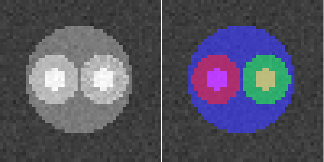This is a MATLAB/C++ for our multi-region segmentation paper [1].
The code supports segmentation with arbitrary number of regions, inclusion and exclusion constraints.
Results from a toy example.
- MATLAB and a c++ compiler.
- Run mex -setup.
- Run example.m in MATLAB, the mex'ed c++ code compiles automatically.
All functionally is described in example.m.
-
To calculate the correct weights for the regularization the code uses "Sphere voronoi" [2].
-
If you use the solver based on lagrangian duality, the code uses the max/flow min solver by Yuri Boykov and Vladimir Kolmogorov [3] which reuses flow as described in [4].
-
If you use roof duality, the code uses the QPBO software [5].
Martin Rykfors has written a more efficient solver if your problem only have inclusions constraints and you are satisfied with standard connectivities. More details in his Master thesis and his git repository.
-
Johannes Ulén, Petter Strandmark and Fredrik Kahl. [An Efficient Optimization Framework for Multi-Region Segmentation based on Lagrangian Duality] (http://www.maths.lth.se/vision/publications/publications/view_paper.php?paper_id=531) IEEE Transactions on Medical Imaging 2013.
-
John Burkardt Sphere voronoi.
-
Yuri Boykov and Vladimir Kolmogorov. [An Experimental Comparison of Min-Cut/Max-Flow Algorithms for Energy Minimization in Computer Vision.] (http://pub.ist.ac.at/~vnk/software.html) IEEE pattern analysis and machine intelligence 2004.
-
Kohli, Pushmeet, and Philip HS Torr. "Dynamic graph cuts for efficient inference in markov random fields." IEEE pattern analysis and machine intelligence 2007.
-
C. Rother, V. Kolmogorov, V. Lempitsky, and M. Szummer. [Optimizing binary MRFs via extended roof duality.] (http://pub.ist.ac.at/~vnk/software.html) IEEE Conference on Computer Vision and Pattern Recognition, 2007.
